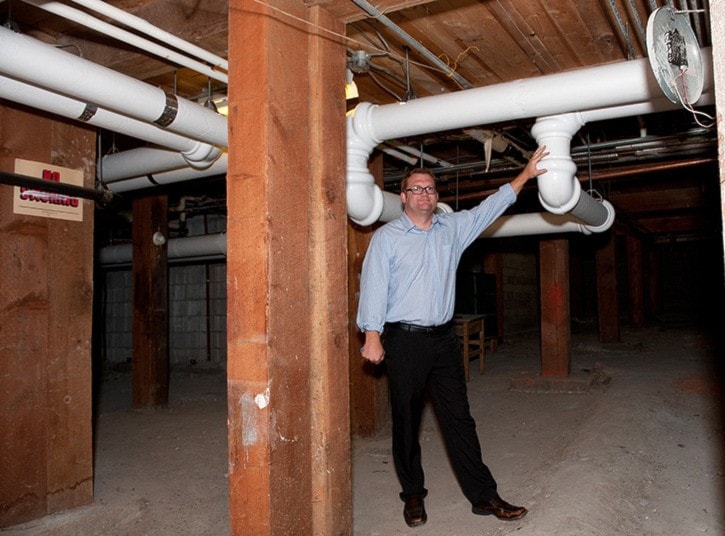PORT McNEILL—North Island Secondary School students will get no relief from their lectures and exams this fall and winter. But they can breathe a little easier, nonetheless.
A unique new heating system, utilizing “waste” heat recaptured from ice production at nearby Chilton Regional Arena, should get its first test in the coming week and is expected to go on-line throughout the school’s classrooms shortly thereafter, School District officials announced.
“I’m excited to fire it up and feel how much of a difference it makes,” NISS principal Jay Dixon said while providing a tour of the school last week.
The new system replaces one of the oldest still operating in a B.C. school, a Rube Goldberg assembly of pieces added as the school expanded over the past 40-plus years. For several years Dixon has been using school funds to purchase space heaters — including 10 of them last year alone — to supplement the inconsistent
“What we had was a patchwork of heating systems,” said Dixon. “You’d go from one room that was hot and the next one would be ice-cold. But the worst part was the lack of circulation. I have to think this is going to help the kids concentrate and learn better. And, after all, that’s what they’re here for.”
The new system will draw heated water through an eight-inch pipe run from the arena and, via a pair of large heat pumps, distribute it through an extensive plumbing system in the school’s labyrinthine basement and into classrooms. Each room has its own air exchanger, controlled by computer, which draws in cool air and vents heated air back out to the class.
The unique joint system was approved in separate votes of the Regional District of Mount Waddington and School District 85 boards earlier this year.
NISS, which has one of the oldest heating systems of any school in the province, was accepting tenders for a traditional HVAC upgrade two years ago when it suspended the process after the preferred contractor added substantial costs when asked to spread the work out over two summers.
At that time, treasurer John Martin noted the regional district had been looking into a heat-recapture system to enhance its own operations at Chilton Arena, and was given the board of trustees’ blessing to explore a partnership.
“We’ve actually spent a little more money than we initially expected, but we ended up with a much better system, much more cost effective in the long term,” said John Martin, School District 85 treasurer.
The original tender was in the neighbourhood of $1 million, while the current system cost roughly $1.4 million to install. Part of that expense was offset by carbon-neutral grants from the government. The savings going forward, however, will more than make up the difference, even as the school district pays the RDMW a utility fee for the heat.
“The problem with the old system was circulation,” said Martin. “The (replacement) system we were exploring was designed to update the heating and also provide fresh air. But fresh air has to be heated. What we’ve got now, in fact, is an updated system with air flow, with a lower utility cost, and that’s something we hadn’t anticipated.”
The Regional District operates the arena on a lease agreement with the Town of Port McNeill. It began researching the heat-recovery system to cut costs and improve efficiencies in its operations. The system will provide heat to the arena’s common areas and locker rooms, in addition to providing heated water for the showers.
The RDMW’s biggest savings will come from powering its dehumidifier with a heat pump connected to the recovery system, rather than the current method of burning propane.
“We’ve been improving our own efficiencies,” said Fletcher. “And that will make more (heat energy) available even than the amount estimated for the school’s need.”
Part of those efficiencies include improvements to the arena’s existing plumbing and heating system.
“We’ve found there are five or six separate plumbing systems that have been added on since it was built,” arena manager Gerry Little said. “We’re kind of peeling back the Band-aid.”
Similar systems have been installed in recreation complexes in greater Victoria and in Campbell River, and the excess heat is used to warm or provide power to various facilities within those complexes.
What makes the Port McNeill system unique is the partnership between the RD and the school district to help heat an off-site facility.
“It works for both of our operations,” RDMW administrator Greg Fletcher said.
And it’s got built-in capacity to expand at both ends, as well as valves installed along the pipe run that could allow the Broughton Curling Club and/or the Town’s swimming pool to tap in, should the Town choose to do so in the future.
“This has worked out extremely well,” said Martin. “We’ve been delighted with the vision of the RD. We initially were’’ sure if it would be this successful, but when we got our engineers together with their engineers, it all worked out perfectly.
“The regional district is going to have reduced costs, and we’re going to have a much better system.”
